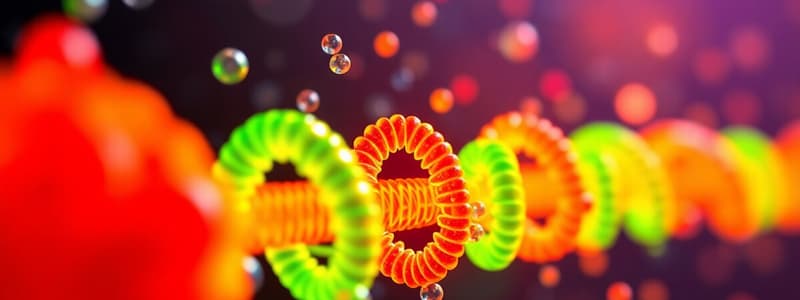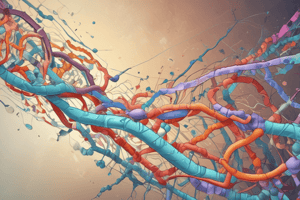Podcast
Questions and Answers
What is the significance of studying the 3D shape of proteins?
What is the significance of studying the 3D shape of proteins?
- It helps to understand their molecular mechanisms of action. (correct)
- It identifies the amino acid sequence.
- It assesses the temperature stability of proteins.
- It determines the weight of the protein.
The first complete amino acid sequence of a protein was determined using just a few micrograms of protein.
The first complete amino acid sequence of a protein was determined using just a few micrograms of protein.
False (B)
What reagent is used to sequence protein fragments according to the outlined methodology?
What reagent is used to sequence protein fragments according to the outlined methodology?
Edman reagent
To determine the number of protein chains, one method that can be used is __________.
To determine the number of protein chains, one method that can be used is __________.
Match the following methods with their appropriate descriptions:
Match the following methods with their appropriate descriptions:
What is the primary purpose of using endopeptidases in the fragmentation of polypeptide chains?
What is the primary purpose of using endopeptidases in the fragmentation of polypeptide chains?
Direct sequencing can be used effectively for polypeptides longer than 60 amino acids.
Direct sequencing can be used effectively for polypeptides longer than 60 amino acids.
What reagents are commonly used to perform the cleavage of peptide bonds in acidic conditions?
What reagents are commonly used to perform the cleavage of peptide bonds in acidic conditions?
The complete sequence obtained by combining peptide fragments is: Phe-Trp-Met-Gly-Ala-Lys- _____ -Met-Asp-Gly-Arg-Cys-Ala-Gln.
The complete sequence obtained by combining peptide fragments is: Phe-Trp-Met-Gly-Ala-Lys- _____ -Met-Asp-Gly-Arg-Cys-Ala-Gln.
Match the following methods with their uses in peptide sequencing:
Match the following methods with their uses in peptide sequencing:
Which method is specifically limited to identifying di-tripeptides?
Which method is specifically limited to identifying di-tripeptides?
Hydrazine is used to identify the N-terminal of amino acids.
Hydrazine is used to identify the N-terminal of amino acids.
What is the advantage of using the Edman reagent for N-terminal residue identification?
What is the advantage of using the Edman reagent for N-terminal residue identification?
The method using dansyl chloride is used for the identification of the N-terminal amino acid by ___________________.
The method using dansyl chloride is used for the identification of the N-terminal amino acid by ___________________.
Match the following identification methods with their corresponding end (N-terminal or C-terminal):
Match the following identification methods with their corresponding end (N-terminal or C-terminal):
What is a feature of the process that uses alkaline conditions for amino group identification?
What is a feature of the process that uses alkaline conditions for amino group identification?
Insulin has a phenylalanine (phe) N-terminal.
Insulin has a phenylalanine (phe) N-terminal.
What happens to the peptide after the removal of the N-terminal residue?
What happens to the peptide after the removal of the N-terminal residue?
What is the primary role of carboxypeptidase in protein analysis?
What is the primary role of carboxypeptidase in protein analysis?
Hydrazine treatment is effective for identifying C-terminal amino acids without any side reactions.
Hydrazine treatment is effective for identifying C-terminal amino acids without any side reactions.
What is the purpose of alkylation in protein analysis?
What is the purpose of alkylation in protein analysis?
The cleavage of disulfide bonds in proteins often requires reducing agents such as __________ or __________.
The cleavage of disulfide bonds in proteins often requires reducing agents such as __________ or __________.
Match the following terms with their descriptions:
Match the following terms with their descriptions:
Which of the following methods can be used to separate polypeptide chains based on size?
Which of the following methods can be used to separate polypeptide chains based on size?
Denaturing conditions can include low temperature and high salt concentration.
Denaturing conditions can include low temperature and high salt concentration.
What is the purpose of exposing proteins to heat during denaturation?
What is the purpose of exposing proteins to heat during denaturation?
Flashcards
Protein Structure
Protein Structure
The 3D arrangement of amino acids in a protein, crucial for understanding its function.
Amino Acid Sequence Determination
Amino Acid Sequence Determination
The process of identifying the order of amino acids in a protein.
Protein Subunits
Protein Subunits
Individual chains that make up a protein.
Disulfide Bonds (S-S Bonds)
Disulfide Bonds (S-S Bonds)
Signup and view all the flashcards
Edman Degradation
Edman Degradation
Signup and view all the flashcards
Protein Sequencing
Protein Sequencing
Signup and view all the flashcards
Fragmentation
Fragmentation
Signup and view all the flashcards
Endopeptidases
Endopeptidases
Signup and view all the flashcards
Peptide Sequencing
Peptide Sequencing
Signup and view all the flashcards
Limited Proteolysis
Limited Proteolysis
Signup and view all the flashcards
N-terminal identification
N-terminal identification
Signup and view all the flashcards
Sanger's method
Sanger's method
Signup and view all the flashcards
FNDP method
FNDP method
Signup and view all the flashcards
Edman degradation (PITC)
Edman degradation (PITC)
Signup and view all the flashcards
Acid hydrolysis
Acid hydrolysis
Signup and view all the flashcards
Dansyl chloride method
Dansyl chloride method
Signup and view all the flashcards
C-terminal identification
C-terminal identification
Signup and view all the flashcards
Phenylthiohydantoin
Phenylthiohydantoin
Signup and view all the flashcards
C-terminal amino acid identification
C-terminal amino acid identification
Signup and view all the flashcards
Protein cleavage
Protein cleavage
Signup and view all the flashcards
Reduction of disulfides
Reduction of disulfides
Signup and view all the flashcards
Alkylation
Alkylation
Signup and view all the flashcards
Protein Denaturation
Protein Denaturation
Signup and view all the flashcards
Ion Exchange Chromatography (IEC)
Ion Exchange Chromatography (IEC)
Signup and view all the flashcards
Study Notes
Protein Sequencing
- Protein sequencing is the process of determining the order of amino acids in a protein.
- Covalent structures of proteins and nucleic acids are important for protein sequencing.
- Proteins have various functions: enzymes (active sites for substrate binding), structural components (like creatinine, hemoglobin, myoglobin), and hormones (like peptide hormones and insulin).
- Proteins have four levels of structure.
Levels of Protein Structure
- Primary structure: The linear sequence of amino acids in a polypeptide chain.
- Secondary structure: Local folding of the polypeptide chain, stabilized by hydrogen bonds (e.g., alpha-helices, beta-pleated sheets).
- Tertiary structure: Three-dimensional folding of a protein due to side chain interactions (e.g., hydrogen bonds, ionic interactions, van der Waals forces, disulfide bonds).
- Quaternary structure: Protein consisting of more than one amino acid chain that interact. Insulin is an example.
Primary Structure
- Is the amino acid sequence
- Amino acids are connected by peptide bonds.
- Each amino acid unit is called a residue.
Determination of Primary Structure
- The primary structure is crucial for understanding a protein's 3D shape, function, and evolutionary relationships.
- Mutations in amino acid sequences can lead to diseases, providing insights for developing therapies.
- First complete amino acid sequence of a protein (insulin) was determined in 1953 using 100 grams. Now, it can be done using micrograms.
Sanger's Strategy
- For protein sequencing:
- Preparation: Determine the number of subunits, cleave disulfide bridges, separate/purify polypeptide chains.
- Fragmentation: Cleave chains into fragments less than 50 amino acids, then separate and purify the fragments.
- Sequencing: Sequence the fragments using the Edman reagent.
- Organization: Compare overlaps of fragments to determine the order and position of the disulfide bonds.
Protein Sequencing Example
- Purify a protein with 7 amino acids
- Expose to different proteolytic agents to obtain fragments.
- Fragments are used to determine the sequence based on overlaps.
Sequencing of Proteins
- Once the amino acid compositions are known, determine the specific sequence.
- Edman Degradation: A technique to determine the first amino acid.
- Exposure to phenyl isothiocyanate labels the first amino acid.
Cleaving Peptide Bonds
- Mildly acidic conditions cleave the first peptide bond, releasing the labeled amino acid.
- Repeated procedures determine the entire sequence.
Step 1: Preparation for Sequencing
- Identify the number of chains using SDS-PAGE.
- Identify N-terminal and C-terminal amino acids.
- Use methods like Sanger's method (DNFB), Dansyl chloride, PITC/Edman reagent, aminopeptidase (identifying N-terminus), and exopeptidases (identifying C-terminus).
Step 2: Fragmentation
- Use enzymes or chemicals (e.g., CNBr) to fragment polypeptide chains.
- Endopeptidases cleave peptide bonds within a protein's internal regions.
Specificity of Peptide Cleavage
- Enzymes like trypsin, chymotrypsin, elastase, and thermolysin have specificities for cleaving peptide bonds.
- Knowing their specificities gives insights into the sequence of the peptide.
- Reaction rates vary depending on the residue. This can impact the order of the amino acids.
Separation and Purification of Polypeptides
- Reduction of disulfide bonds is necessary to separate chains.
- Denaturation (heat) exposes SH groups to cleave the disulfide bonds.
Protection of Sulfhydryl Groups
- Alkylation: Preventing disulfide reformation by attaching a molecule (like iodoacetate) to the sulfur atom in the SH group.
Separation and Purification and Characterization of Polypeptide Chain
- Denaturation: Acidic-basic- low salt- high temperature- denaturant (urea-guanidin hypochloride- SDS)
- Separate chains by charge (IEC) or size (SEC-HPLC).
- Estimate the number of residues from the molecular weight (MW) using SEC-SDS-PAGE, and MS.
Step 2: Fragmentation of Polypeptide Chains
- Use enzymes (e.g., endopeptidases like trypsin) or chemicals (e.g., CNBr) to fragment the polypeptide chain.
- Endoproteases cleave internal peptide bonds.
- Some enzymes (e.g., trypsin, chymotrypsin) have specificities for cleaving peptide bonds after certain amino acid residues.
Ordering the Peptide Fragments
- Overlapping fragments from different cleavage points are compared.
- This provides information to establish the correct order of amino acids.
Identifying the Position of Disulfide Bonds
- This requires maintaining disulfide bonds during the cleavage process.
- Repeat fragmentation followed by separation (reverse phase HPLC) to identify disulfide bonds.
Determining Amino Acid Composition
- Employ hydrolysis (e.g., 6M HCl at high temperature) to break peptide bonds.
- Separate the amino acids via ion-exchange chromatography.
- Analyze the quantity of each amino acid using ninhydrin.
Example: Sequencing a Heptapeptide
- Provides illustration of the steps to determine the sequence of a small peptide using Sanger reagent, different enzyme treatments, and cleavage reactions (like by CNBr).
Studying That Suits You
Use AI to generate personalized quizzes and flashcards to suit your learning preferences.




